Jun 09, 2023 Optimistic Closing Activities to Celebrate, Reflect, and Connect to Future Learning
This post offers engaging reflection techniques to make the most of end of program/end of school year moments with optimistic endings that cultivate lasting lessons:
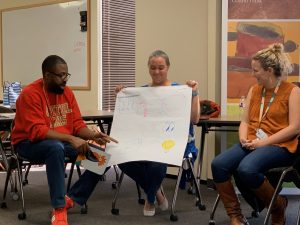 As readers of this blog know, I am passionate about the practice of reflection and the importance of intentionally weaving it throughout programming from beginning to end.
As readers of this blog know, I am passionate about the practice of reflection and the importance of intentionally weaving it throughout programming from beginning to end.
Reflection brings learning to life. Neuroscience shows that reflective practice connects educational experiences and real-life situations and creates pathways to future learning. Research on attention and retention emphasizes the importance of the “primacy-recency effect,” demonstrating that learners remember the most about the first and last moments of an experience. Educational Neuroscience indicates that the first five minutes of a program, class, or session is the key time to hook and engage participants, create context, and set a positive tone. The last moments of an experience are your opportunity to tie it all together and cultivate lasting lessons.
In past blog posts, I’ve focused on strong beginnings and practical, welcoming reflections/hooks to engage and set a positive tone. Today’s post focuses on optimistic closing reflection techniques to create meaningful endings that continue beyond the experience:
Group Drawing
There is great power when learners create symbols and pictures to represent feelings and experiences. Throughout history, humans have used artistic expression to explore, understand, and share ideas and experiences. Involvement in individual/group art activities can be a rich, reflective process for participants. Group Drawing is my favorite closing reflective activity to wrap up a group experience, lesson, or workshop. I made it up on the fly with an in-person group more than twenty years ago when I had just a few moments left in a session and wanted to end with something quick but positive, collaborative, and reflective. I had many flip charts and markers around, so I divided the group into smaller teams of four to five people and asked them to collaboratively create some kind of symbolic or pictorial representation of our time together. Click here to read more.
Three Cards/Objects to Tell Our Story— and a Fourth for How We Are Going to Get There
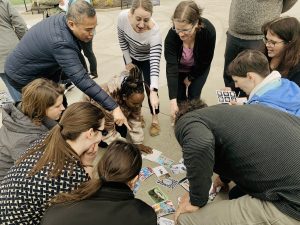 Using imagery sparks positive reflective conversations and feedback in a non-intimidating way — strengthening the community and cultivating positive norms. My “go-to” way to use these tools with groups is collaborative—i.e., inviting the group to agree upon images representing their collective vision or experience together—which becomes a reflection, communication, and team-building experience. This prompt sparks meaningful dialogue and focused collaborative reflection on shared experiences, successes, and continued reflection on future goals, vision, and essential conversations about the group norms, actions, and behaviors that will help them get to where they want to be. This technique can be used at the beginning of programs for goal setting, mid-year or mid-program to check in on progress and group norms, and at the end, as a powerful closing on successes, accomplishments, hopes, and ideas for the future.
Using imagery sparks positive reflective conversations and feedback in a non-intimidating way — strengthening the community and cultivating positive norms. My “go-to” way to use these tools with groups is collaborative—i.e., inviting the group to agree upon images representing their collective vision or experience together—which becomes a reflection, communication, and team-building experience. This prompt sparks meaningful dialogue and focused collaborative reflection on shared experiences, successes, and continued reflection on future goals, vision, and essential conversations about the group norms, actions, and behaviors that will help them get to where they want to be. This technique can be used at the beginning of programs for goal setting, mid-year or mid-program to check in on progress and group norms, and at the end, as a powerful closing on successes, accomplishments, hopes, and ideas for the future.
First, lay out a collection of images (you could use our Pick-a-Postcards or found images, or you also could use objects like Miniature Metaphors or found items from nature and junk drawers). Secondly, invite participants to collaboratively work together to choose three that tell the story of their past, present and future journeys. If it is a large group, you can divide them into smaller focus areas (grade-level teams, departments on campus, etc.) to engage in this reflection.
~The first card/object represents where they were at the start of their time together (either when they first came together as a team.
~The second card represents where they are now as a group.
~The third represents where they hope to be in the future time next year -depending on the group.
When they have agreed upon their “story.” I ask the group or subgroup to share their postcard image choices. Interestingly when I do this with large groups, and the subgroups come back and share their three choices with the whole group, they often choose some of the same cards.
• At this point, I add a “part two” to the reflection and ask them to… Click here to read the full article.
Strengths and Accomplishments Appreciation and Reflection
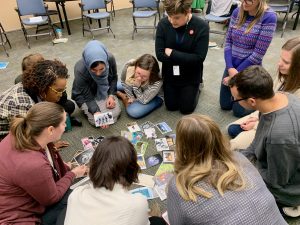 Postcards are one of my favorite tools for sharing appreciation and celebrating group members’ strengths, positive qualities, and contributions. Objects such as toy animals or “Miniature Metaphors” could also be used for this purpose, but I tend to use my “Pick-a-Postcards” as I like to have participants write the note to themselves on the back of their postcards, which I send to them later. I regularly facilitate this activity with both online and in-person groups. Depending on the setting and participant numbers, it can be facilitated as a whole group experience or in smaller breakout groups – whichever suits your situation. This is designed for groups that have been working together for a significant period of time and know each other well. Click Here to read more.
Postcards are one of my favorite tools for sharing appreciation and celebrating group members’ strengths, positive qualities, and contributions. Objects such as toy animals or “Miniature Metaphors” could also be used for this purpose, but I tend to use my “Pick-a-Postcards” as I like to have participants write the note to themselves on the back of their postcards, which I send to them later. I regularly facilitate this activity with both online and in-person groups. Depending on the setting and participant numbers, it can be facilitated as a whole group experience or in smaller breakout groups – whichever suits your situation. This is designed for groups that have been working together for a significant period of time and know each other well. Click Here to read more.
Postcard to Your Future Self
This is one of my favorite reflective activities because it encourages learners to reflect on their strengths, celebrates their accomplishments, and clarify their goals. The postcard gives them a tangible reminder of their learning experience for the future. I regularly use this as a closing reflection activity in my workshops. At the end of a seminar or course, participants write down on their postcard at least one thing they learned from the workshop activities or through a conversation with a peer they don’t want to forget. I then ask them to write a commitment to themselves around changing, improving, or trying something new in their practice as an educator. I sent the postcards as a reminder a few months later. Many workshop and training attendees later reported that the card arrived on “just the right day” to remind them of a personal strength, lesson, or goal. Click here to read more.
Celebrations Charades Race
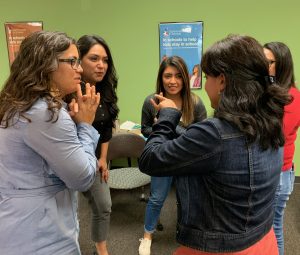 In this variation of my favorite active academic or training content review game, I use the group’s successes, highlights, and positive experiences as their “content” for the game. For example, at the end of a week of training at a camp program, I invited group members to each write down a highlight or positive, memorable moment from their week together. They placed their written moments in a jar, and then I sorted through them and chose five that stood out for the charades relay. I’ve done the same with middle school students on the last day of school with highlights and funny moments from the school year. Here is the link to the academic review variation you can adapt for a celebrations focus: To read more click here.
In this variation of my favorite active academic or training content review game, I use the group’s successes, highlights, and positive experiences as their “content” for the game. For example, at the end of a week of training at a camp program, I invited group members to each write down a highlight or positive, memorable moment from their week together. They placed their written moments in a jar, and then I sorted through them and chose five that stood out for the charades relay. I’ve done the same with middle school students on the last day of school with highlights and funny moments from the school year. Here is the link to the academic review variation you can adapt for a celebrations focus: To read more click here.
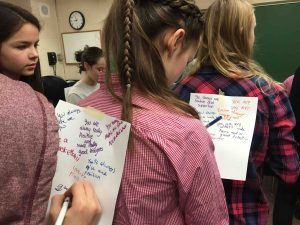 Appreciation Notes
Appreciation Notes
Use this activity with long-term groups to engage participants in showing appreciations and giving feedback in a fun, non-threatening way. It works best with those who know each other well and need some self-esteem boosters and opportunities to celebrate
each others’ strengths. To read more click here.
Peek-a-Who Appreciations
This playful interactive activity is an engaging method for celebrating accomplishments, appreciation of others, using descriptive language (adjectives), listening, healthy trust, respect, reflection, celebrating the community, and positive group norms. 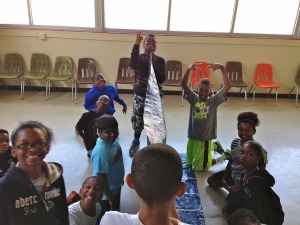 In this variation of the “Peek A Who” name game (see my fall 2012 post) one participant from each team is chosen to sit (or stand) with their back to the tarp/blanket. Two facilitators or group members hold the tarp/blanket vertically between them so that they can’t see who is on the other side of the tarp.To read more, click here.
In this variation of the “Peek A Who” name game (see my fall 2012 post) one participant from each team is chosen to sit (or stand) with their back to the tarp/blanket. Two facilitators or group members hold the tarp/blanket vertically between them so that they can’t see who is on the other side of the tarp.To read more, click here.
Please email me for more ideas for celebrating, reflecting, and creating lasting lessons at jen@experientialtools.com. These activities and other related strategies are described in more detail in the Inspired Educator, Inspired Learner book and Tips & Tools for the Art of Experiential Group Facilitation.



No Comments